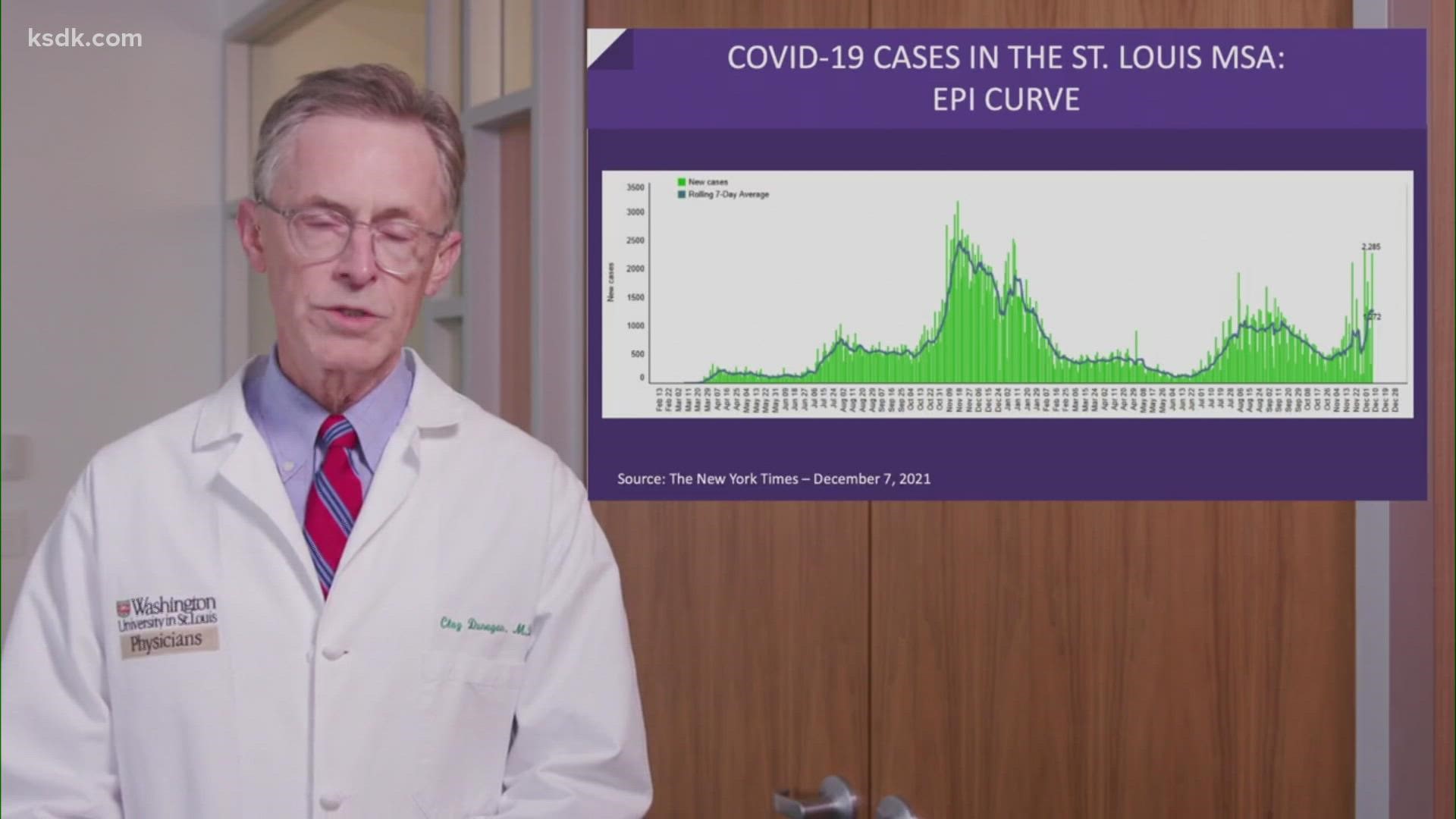ST. LOUIS — The leader of the St. Louis Metropolitan Pandemic Task Force said case rates in the St. Louis area are starting to mirror those reported late last year, and hospitals in the area are in a worse position to handle a potential surge.
"We have less buffer capacity than we had a year ago," Dr. Clay Dunagan said in a press briefing Tuesday afternoon. "There are fewer people available, fewer caregivers. Staffing concerns continue to plague hospitals all across the country, and St. Louis is no exception."
Cases in the St. Louis area have increased significantly in recent days, and although Dr. Dunagan said that is partially due to a backup of tests due to the Thanksgiving holiday, the task force has seen hospitalizations increase steadily.
Dr. Dunagan said the seven-day average of cases is beyond the peak reported during the delta surge earlier this year and is on a slope that is comparable to the steep increases seen in October and November of 2020 even though vaccinations are widely available.
The reproduction number calculated by the task force was 1.43, which is among the highest ever reported by the task force. Dr. Dunagan said that number is likely artificially high due to the holiday backlog of cases, but the actual number is at least in the 1.2 range. He said even a reproduction number of 1.2 is still bad news for the region.
"The bottom line is I think we're well above the 1.2 number at the very least, which means this would expand fairly rapidly without interventions," Dr. Dunagan said.
Should those trends continue, Dr. Dunagan said hospitals could begin limiting elective healthcare procedures.
As of Tuesday, 91% of hospital beds were occupied in task force hospitals, and 82% of ICU beds were taken.
Dr. Dunagan said the increase in cases is likely due to a number of factors that all add up to an easier path for the virus to replicate in the community.
"I think what we are seeing in this time period is clearly partially due to reduced masking and social distancing, as people have gotten tired of these precautions," Dr. Dunagan said. "In addition, colder weather is driving people indoors, so there is more contact among individuals in the population and more opportunities for spread."
Dr. Dunagan said it is unclear if the omicron variant is impacting the recent increase, but he said the need for preventative measures in the community and by the hospital system could increase if the new variant does add to the existing issues.
"If omicron is not here yet, we're already having a pretty significant surge, and omicron's arrival will, no doubt, only accelerate the number of cases," Dr. Dunagan said. "So I think we have to be prepared to take pretty aggressive action if we want to contain the current spread."
Dr. Dunagan said waning immunity for people who got their vaccination early is likely playing a role in the current increase as well. He said it highlights the importance of getting a booster dose of the vaccine for all age groups.
As of now, all people over the age of 18 are eligible for a booster if they are six months removed from their second dose of the Moderna or Pfizer vaccine or two months removed from receiving the Johnson & Johnson vaccine.
The data for December 6, 2021, is as follows:
- New hospital admissions (data lagged two days) increased – from 40 Monday to 57 Tuesday.
- The seven-day moving average of hospital admissions (data lagged two days) increased – from 54 Monday to 57 Tuesday.
- The seven-day moving average of hospitalizations increased – from 408 Monday to 424 Tuesday.
- Inpatient confirmed COVID-positive hospitalizations increased – from 459 Monday to 479 Tuesday.
- Inpatient suspected COVID-positive hospitalizations decreased - from 30 Monday to 27 Tuesday.
- The number of confirmed COVID-positive patients in the ICU increased – from 90 Monday 98 Tuesday.
- The number of confirmed COVID-positive patients on ventilators increased – from 56 Monday to 61 Tuesday.
- 3 COVID deaths were reported Monday.
- The seven-day moving average of COVID deaths decreased – from 6 Monday to 5 Tuesday.
- Across the system hospitals, 60 patients were discharged Monday bringing the cumulative number of COVID-19 patients discharged to 31,093.
- Of the 454 hospitalized COVID patients in the three reporting Task Force hospital systems Tuesday – 103 are fully vaccinated. That’s 23% of the patient population.
- There are 6 COVID-positive children who are 0-11 years of age in Task Force hospitals.
- There are 6 COVID-positive children who are 12-18 years of age in Task Force hospitals.
- There are 0 COVID-positive children who are 0-11 years of age and in the ICU.
- There is 1 COVID-positive child who is 12-18 years of age and in the ICU.
- Tuesday’s staffed bed hospital capacity is at 91% an average across our task force hospitals. The ICUs are at 82% of their total staffed bed capacity.

